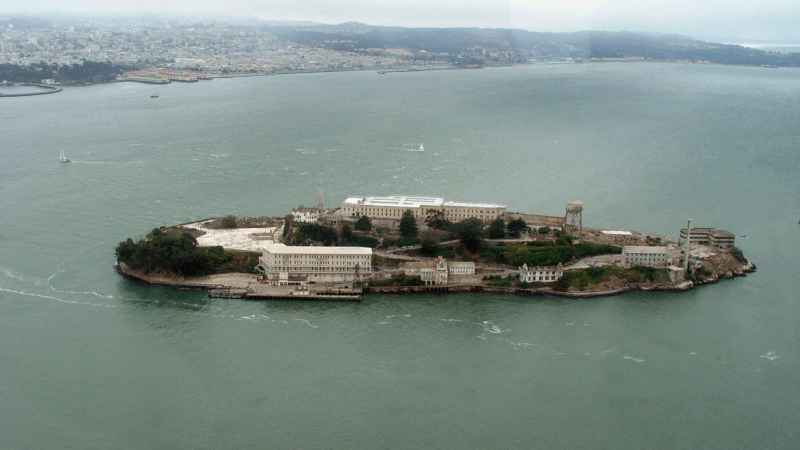Trump says he will reopen Alcatraz for the ‘most ruthless and violent’ prisoners
President Trump says he is ordering federal agencies to rebuild and reopen Alcatraz — the notorious maximum security prison that closed more than 60 years ago.
“I am directing the Bureau of Prisons, together with the Department of Justice, FBI, and Homeland Security, to reopen a substantially enlarged and rebuilt ALCATRAZ, to house America’s most ruthless and violent Offenders,” Trump said in a post on Truth Social.
The historic former U.S. Penitentiary Alcatraz, opened in 1934, is widely known as The Rock. Its buildings dominate the craggy landscape of Alcatraz Island, which lies about 1.5 miles north of San Francisco’s famed Fisherman’s Wharf.
Alcatraz once housed dangerous criminals such as the infamous mobster Al Capone, under an incarceration strategy that sought to concentrate difficult prisoners in one facility, segregating them from less dangerous inmates in the prison system.
Trump’s message suggests he wants to restore Alcatraz to its original dual purpose. The twin goals for building the original prison, according to the Federal Bureau of Prisons, were “to deal with the most incorrigible inmates in Federal prisons, and to show the law-abiding public that the Federal Government was serious” about stopping rampant crime in the 1920s and 1930s.”
“REBUILD, AND OPEN ALCATRAZ!” the president said on Truth Social. He added later in his message, “The reopening of ALCATRAZ will serve as a symbol of Law, Order, and JUSTICE.”
Trump did not provide details about a timeline for reopening the prison. And the National Park Service did not reply to NPR’s request for comment about the president’s new plan for Alcatraz before this story published.
But enacting Trump’s proposal would come with a steep price tag, both for constructing and operating a new prison facility on an island whose most plentiful natural resource is sandstone.
Alcatraz was shuttered “because the institution was too expensive to continue operating,” according to the Federal Bureau of Prisons. It said operating the island prison was nearly three times more expensive than any other federal prison at the time.
“This isolation meant that everything (food, supplies, water, fuel…) had to be brought to Alcatraz by boat,” the bureau says. “For example, the island had no source of fresh water, so nearly one million gallons of water had to be barged to the island each week.”
Then-U.S. Attorney General Robert F. Kennedy closed the federal penitentiary in 1963.
Alcatraz is currently a museum administered by the National Park Service, as part of the Golden Gate National Recreation Area since 1972. Placing the prison in historical context, the NPS says it “represents the federal government’s response to post-Prohibition, post-Depression America. Both the institution and the men confined within its walls reflect our society during this era.”
The original impetus for creating the Alcatraz prison, the park service says, lay in the U.S. government’s desire to create a “high-profile prison that represented the Justice Department’s response to fears around public safety and organized crime.”
For federal prison officials, Alcatraz “served as an experiment” in handling problematic inmates, the park service says. It adds, “The model they developed on Alcatraz would later serve as a blueprint for the high security federal prison located in Marion, Illinois.”
Since returning to the White House in January, Trump has unveiled a string of high-profile initiatives that he says will protect public safety and also crack down on unlawful immigration. They include deporting immigrants — and potentially, U.S. citizens — to a maximum security prison in El Salvador.
Alcatraz was initially viewed as a defense outpost in San Francisco Bay when it was brought under federal control by President Millard Fillmore in 1850, according to the NPS.
But the U.S. soon began using the island as a prison.
Groups housed there include: captured Confederates in the 1860s; members of the Hopi Tribe in the 1890s; and prisoners from the 1898 Spanish-American War.
In the early 1900s, it became the site of the U.S. Disciplinary Barracks for the U.S. Army. In 1933, “the island was transferred to the U.S. Department of Justice for use by the Federal Bureau of Prisons,” according to the Bureau of Prisons.
Alcatraz Island is now a popular National Park Service site that’s been open to the public since 1973.
Meet five new species discovered in 2025
A bumpy snailfish, Andean mouse opossum and ancient sea cow were just some of the many species described in 2025.
What to know about Nick Shirley, the YouTuber alleging daycare fraud in Minnesota
Shirley is a 23-year-old self-described "independent YouTube journalist" who made prank videos in high school before pivoting to politics. He participated in a White House roundtable in October.
Greetings from Vienna, where an imperial palace hosts a holiday market for all
Far-Flung Postcards is a weekly series in which NPR's international team shares moments from their lives and work around the world.
Out with the mayo: How Ukrainians reclaim holiday food
For many people from former Soviet countries, New Year's is a big holiday feast time. A Ukrainian restaurant in Washington gives NPR a taste of what's on the menu.
His brother’s mental illness isolated his family. Now he’s helping other caregivers
When it comes to serious mental illness, family caregivers are crucial partners. But often, they must fend for themselves. A new solution offers them support.
Farmers are about to pay a lot more for health insurance
Tariffs, inflation, and other federal policies have battered U.S. farmers' bottom lines. Now many farmers say the expiration of federal health care subsidies will make their coverage unaffordable.






